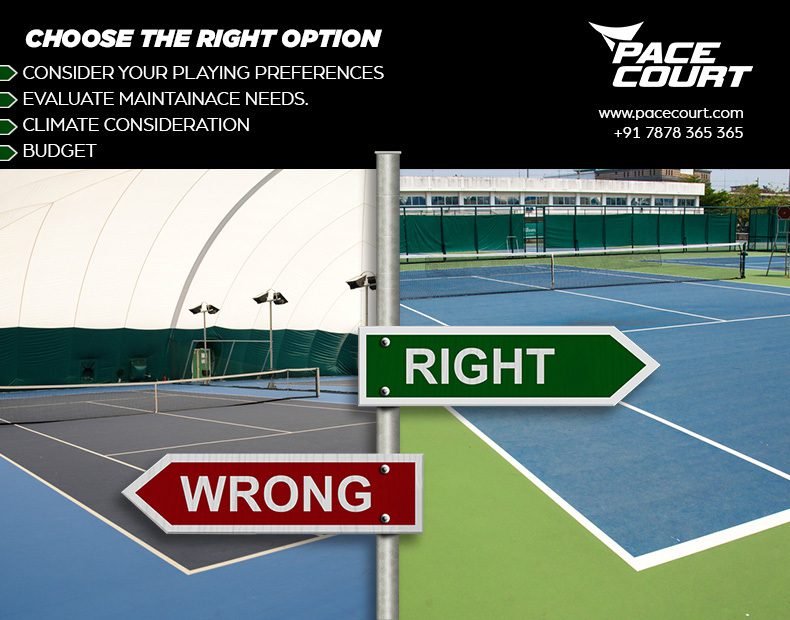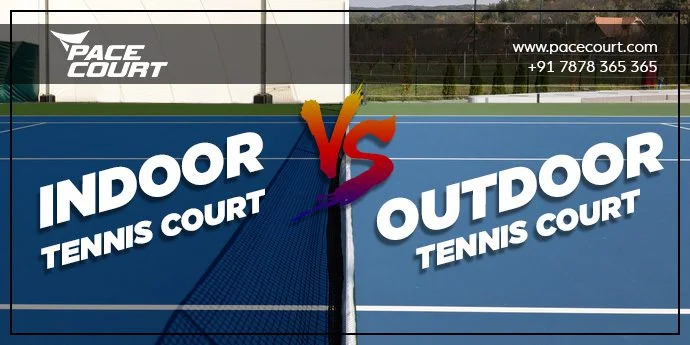There are significant differences in tennis court flooring between indoor and outdoor surfaces. The decision between the two is influenced by a variety of elements such as playing characteristics, maintenance requirements, and environmental considerations. In this article, we will compare Indoor vs Outdoor Tennis Court Flooring, with a focus on the features offered by Pacecourt, a leading brand in the sports industry, highlighting significant aspects and helping you in deciding which option best meets your needs. Let’s explore deeper into this subject of Indoor vs Outdoor Tennis Court Flooring:
Outdoor Tennis Court Flooring:
- Tennis Court Surface:
- There are a variety of surfaces available for outdoor tennis courts, including asphalt, concrete, grass, and artificial grass.
- Asphalt surfaces offer a stable and reliable bounce, making them appropriate for fast-paced games.
- Concrete surfaces are perfect for high-traffic areas since they are durable and require little maintenance.
- Grass floors offer a more traditional feel and a softer impact, but they need routine maintenance like watering and mowing.
- Artificial grass surfaces mimic the appearance and texture of natural grass while requiring less care.
- Maintenance:
- Compared to indoor courts, outdoor tennis court surfaces often require less maintenance.
- These surfaces amade to withstand weather conditions, reducing the necessity of resurfacing and maintenance.
- Grass surfaces need greater maintenance, such as routine trimming, regular watering, and occasional reseeding.
- Construction:
- Similar procedures followed while building an outdoor tennis court as when building one indoors, including levelling the site.
- The surface material of choice, such as asphalt or concrete, is installed on top of a well-prepared base.
- Tennis Court Resurfacing:
- The performance and longevity of outdoor tennis court surfaces may require resurfacing periodically.
- The old surface must removed, any damage must repaired, and a fresh layer of the chosen material must applied.
Indoor Tennis Court Flooring:
- Tennis Court Surface:
- The surfaces of indoor tennis courts are specifically created to offer consistent playing conditions and top performance.
- For indoor courts, synthetic floors, acrylic surfaces, and rubberized materials frequently used.
- These surfaces provide excellent shock absorption, outstanding grip, and controlled ball bounce.
- Maintenance:
- To maintain their longevity and playing quality, indoor tennis court surfaces need to cleaned frequently and periodically maintained.
- Utilising the proper tools and cleaning solutions, cleaning involves removing dust, debris, and dirt from the surface.
- To keep the surface in top condition, routine maintenance required, including the application of protective coatings and quick repairs.
- Construction:
- Site preparation, levelling, and installation of the chosen surface materials are all part of building an indoor tennis court.
- A concrete or asphalt base is often put on top of the flooring to provide stability and longevity.
- Tennis Court Resurfacing:
- In order to restore their playing qualities, indoor tennis court surfaces may need to resurfaced over time.
- Resurfacing involves removing the previous surface, fixing any harm, and adding a fresh coating of the selected substance.
- The court's performance and quality maintained through this approach.

Choosing the Right Option:
- Consider Your Playing Preferences:
- The variety of tennis surfaces offered by outdoor courts allows players to experience various playing styles and natural surroundings.
- Indoor courts provide players who like predictable ball bounce and traction with controlled environments and consistent playing characteristics.
- Evaluate Maintenance Needs:
- Outdoor courts often require less maintenance, while grass surfaces need more attention.
- In order to maintain its quality, indoor courts need to cleaned frequently.
- Climate Considerations:
- Your location's climate should taken into consideration.
- Indoor courts offer a controlled atmosphere that can adjusted to any weather, whilst outdoor courts are more suited to moderate temperatures.
- Budget:
- Tennis courts can cost a lot more or less depending on the surface material, construction needs, and maintenance requirements.
- When choosing between the two possibilities, take your budget into consideration.
Conclusion
Tennis court flooring options can vary depending on a number of criteria, including playing preferences, maintenance requirements, environment, and price. Outdoor courts offer a variety of surface alternatives and a more realistic playing experience, while indoor courts offer controlled playing conditions and reliable performance. To make an informed choice, evaluate your unique requirements and speak with tennis court construction specialists. The correct court surface material must chosen, whether you opt for an indoor or outdoor court, to provide a satisfying and joyful tennis experience.


